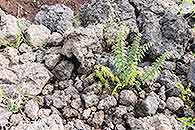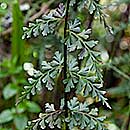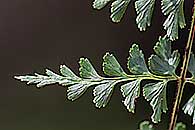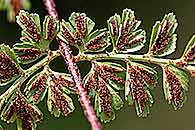Asplenium mildbraedii Hieron.
Synonyms |
|
|---|---|
Common name |
|
Description |
Rhizome short-creeping; rhizome scales dark brown, ovate to narrowly triangular in outline , apex gradually tapering to a point, ending in hair-tip, 1–4 x 0.5 mm, from cordate or peltate base, with paler margin. Fronds spaced, 50–80 cm long, 3-pinnatisect. Stipe black, 25–33 cm long, to 2 mm thick, hairless or nearly so. Lamina oblong in outline, 25–40 x 9–12 cm, apex decrescent. Pinnae 15–20, 2-pinnatisect, deltoid-ovate or deltoid-oblong in outline, to 7.5 x 3.5–4 cm; pinnules trapezoid-rhombic, to 2 x 1–1.3 cm, base cuneate, the ultimate segments spatulate with (sub-)truncate and denticulate apex; scaly when young with scales similar to those of rhizome. Rhachis with ovate (Kivu) or thread-like and lobed (Ninagongo, Usambara) scales. Sori lateral on veins, 2–5 mm long, not reaching margin; indusium entire, to 0.4 mm wide. |
Notes | |
Derivation | mildbraedii: named after G.W.J. Mildbraed (1879-1954), German explorer, botanist specialized in mosses and ferns. He was the plant collector on four German expeditions to Central Africa and keeper at the Berlin Botanical Museum in 1913. |
Habitat | Montane or bamboo forest, alpine zone; fairly widespread with wide habitat and altitude range. |
Distribution worldwide | See African distribution. |
Distribution in Africa |
|
Growth form |
Terrestrial. |
Literature |
|





